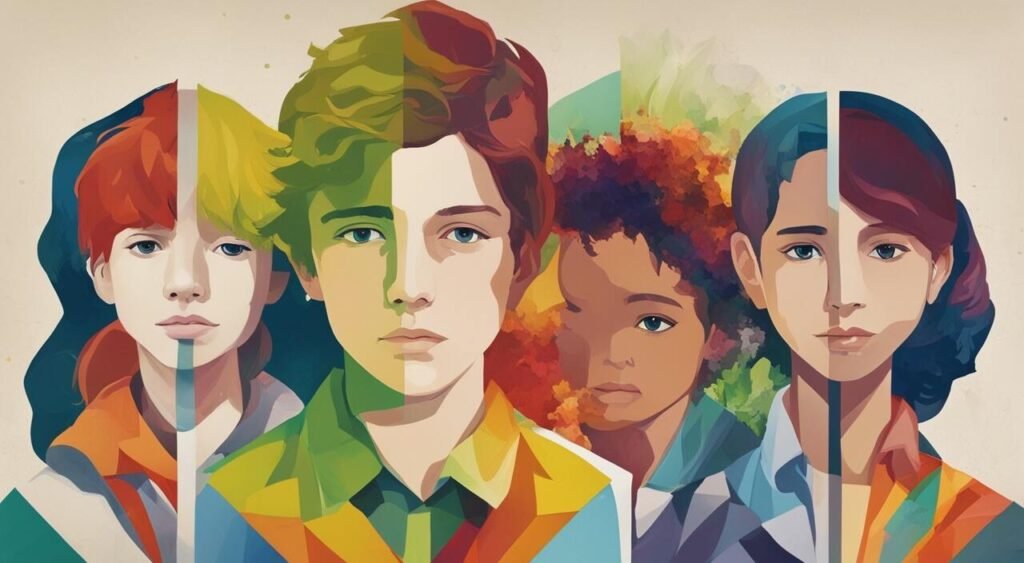Adolescence is the time between being a child and an adult. It comes with big changes in how we look, think, feel, and act. Knowing the main points of adolescence helps us help young people at this critical stage. We’ll look at the seven key traits of adolescence, diving into fast growth, new feelings, and building independence.
Key Takeaways
- Adolescence is a critical transitional period marked by significant physical, cognitive, emotional, and social changes.
- Understanding the seven primary characteristics of adolescence is crucial for supporting young people during this pivotal stage of development.
- The key characteristics include rapid physical changes, hormonal shifts, cognitive and emotional development, appearance consciousness, exploration of romantic relationships and career goals, social and behavioral changes, and the pursuit of independence and autonomy.
- Recognizing the unique challenges and opportunities inherent in adolescence is essential for fostering the healthy development and well-being of young individuals.
- Adolescents undergo a transformative journey as they navigate the path towards adulthood, and providing them with the necessary support and guidance can help them thrive during this pivotal life stage.
Rapid Physical Changes and Hormonal Shifts
Adolescence is a time of fast-growing bodies and big changes. Kids shift into young adults, growing in height and experiencing new body features. This phase is known for the start of puberty, when hormones are all over the place.
Rapid Growth Spurts and Biological Changes
Adolescents, including both girls and boys, grow a lot in this stage. Boys might find their voices deeper, and their bodies more muscular. Girls often go through breast growth and wider hips, with periods starting.
Development of Secondary Sexual Characteristics
At this age, signs of young adulthood appear, showing that you’re no longer a child. These changes, like breasts in girls, happen because of hormones. They tell the body it’s time to mature, though they’re not directly linked to making babies.
Hormonal Fluctuations and Puberty
Hormones like estrogen and testosterone lead to the big changes of puberty. It’s the bridge between being a kid and an adult. This stage brings not just growth in size but also the ability to have children.
Cognitive and Emotional Development
Adolescence brings about not just physical change, but significant cognitive development in adolescence and emotional changes during adolescence too. Teens start to think more abstractly and reason. They sharpen their ability to analyze critically. This helps them figure out who they are and what they believe in.
As they delve into their identity, teens often go through mood swings and feel emotions more intensely. The part of their brain that controls decision-making is still growing. This growth leads to the cognitive and emotional changes seen during adolescence.
Emergence of Abstract Thinking and Reasoning
Adolescents show incredible growth in abstract thinking and reasoning during this stage. This enhanced thinking ability allows them to tackle complex questions. They ponder on their identity, values, and beliefs. Thus, they try to make sense of the world.
Identity Formation and Self-Exploration
An important part of growing up is identity formation in teens. Adolescents start a journey to know themselves better. They want to understand their values and beliefs and their place in society. This can both thrill and puzzle them as they develop their own identity.
Heightened Emotions and Mood Swings
The teenage years are also characterized by intense emotions and shifts in mood. Teens are dealing with changes inside and out. Things like hormones and social life play a big role in their mood changes. The ongoing development of the adolescent brain doesn’t make things any easier.
What are the 7 Characteristics of Adolescence?

Adolescence is marked by major physical changes and new emotions. Young people start to really care about how they look. This can lead to feeling bad about themselves. It might also make it hard for them to see their own worth.
Appearance Consciousness and Body Image Concerns
Youth often worry a lot about how they look. They regularly check themselves against others. This causes many to dislike their bodies and want to change how they look.
Figuring out these feelings is crucial for growing up. It shapes how they feel and how they make friends.
Development of Sexual Attraction and Romantic Interests
In adolescence, feelings about love and attraction grow. Teens start to explore what attracts them and learn about romantic relationships. This includes trying things out, forming strong bonds, and setting limits in close relationships.
Exploration of Career Goals and Future Planning
Adolescence is when teens think a lot about jobs and their future. They look at what they like and dream about. Planning ahead can be both fun and scary as they move towards being grown-ups.
Social and Behavioral Changes
As adolescents grow, they face big shifts in how they act and interact. At this time, making friends and fitting in becomes really important. They look for a group where they feel they belong, which affects their behavior and choices.
Teens also start taking more risks and trying new things. They want to be more independent. This means sometimes they do things that are not safe. It’s all part of growing up, finding out who they are, and learning what they like.
Wanting to do things their own way is key. Teens often challenge rules from adults in their life. This is their way of trying to control their own future. It’s a step towards being an adult, where they decide things for themselves.
All these changes are really important for teens. They help shape how teens see themselves, relate to others, and understand the world. By supporting them through this, we can help teens grow into confident and healthy adults.
Conclusion
Adolescence is a stage with many changes: physical, mental, emotional, and social. By knowing the seven key aspects of adolescence, we can help young people. This includes their fast-changing bodies, developing minds and feelings, and caring about how they look. Adolescents also start to notice romantic relationships and think about their future careers. Important social and behavior changes happen too during this time.
It’s vital to offer adolescents the right support and advice during these significant changes. Understanding their needs and offering help suited to their age can make a big difference. This way, we help them build on their strengths, find who they are, and guide their choices for the future.
Supporting adolescents is not just a duty but a chance to impact lives positively. By really understanding adolescence, we can create a caring environment. This environment promotes their growth, helps them become stronger, and prepares them well for successful adult life.
FAQ
What are the 7 key characteristics of adolescence?
There are seven main things that happen during adolescence. These seven factors are:
1. Your body grows quickly and your hormones change a lot.
2. Your mind and feelings grow too.
3. You start caring a lot about how you look and what others think of you.
4. You begin to like others romantically and find some people attractive.
5. You start thinking about what you want to do in the future.
6. The way you act and how you get along with others changes.
7. You want to do things more on your own and be more independent.
What are the physical changes during adolescence?
Adolescents grow a lot in a short time. Their bodies and minds change, thanks to growth spurts and new hormones. Boys may notice their voices getting deeper and begin to grow more facial hair. They also gain more muscle. Girls, on the other hand, often see their breasts develop and their hips widen. They also start their periods.
How does cognitive and emotional development occur during adolescence?
Your mind also grows during adolescence. You start thinking in more complex ways. This includes critical thinking and analyzing things more deeply. This can make you think a lot about who you are and what you believe. It may also cause a lot of strong feelings and change your moods quickly. It’s all part of figuring out who you are.
What are the social and behavioral changes during adolescence?
Your friends and how you get along with them become super important. You want them to like you, and you want to feel like you belong. This can sometimes lead to trying things that are risky. And, you might want to do things your own way more often, which can cause conflict with your parents or other adults. It’s all about trying to be your own person and make your own choices.
How does appearance consciousness and body image develop during adolescence?
During adolescence, you start to really notice how you look. This can make you worried about what others think of you. At the same time, you’re interested in dating and noticing people you find attractive. Thinking about what you might want to do in the future also becomes a big focus for you.





